Why you can trust TechRadar
Hyundai doesn't offer a branded audio system upgrade in the Tucson. Exclusive to the Limited trim levels is an eight-speaker sound system with external amplifier, while the lower trim levels sport a six-speaker system. While there are a total of eight speakers, there are only six discrete audio channels, because Hyundai counts each individual driver as a speaker.
The Tucson has six discrete audio channels: front, rear, center and subwoofer channels. The front doors each have a woofer, tweeter and count as two speakers. Hyundai installs the subwoofer on the side of the cargo area.
The subwoofer and mid-bass is a little muddy, while the tweeters could offer more clarity. I'd say sound quality is adequate for your daily commute, but not as impressive as the premium-branded Infinity or Lexicon systems in the Sonata and Genesis sedans. It's definitely not an audiophile-level system, but I expect more from the range-topping Limited trim.
Driver assists
Hyundai's suite of driver assists includes a blind-spot monitor (BSM) system, backup camera that's standard on Sport and Limited trims, and downhill brake control (DBC) that's standard on all trims. Check the box for the Ultimate Package, and you get lane departure warning (LDW) and automatic emergency braking with pedestrian detection (AEB).
The radar-based BSM aids in lane changes by detecting other cars in the blind spot and provides audible and visual alerts accordingly. Hyundai integrates a flashing indicator into the side mirrors that flashes once if it detects a car in the blind spot.
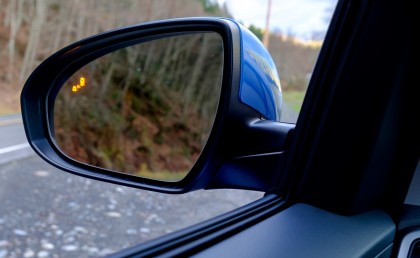
When you use the turn signal and it detects a car in the blind spot or a car that's approaching at a faster rate of speed in the adjacent lane, the indicator flashes rapidly and the car beeps to notify you. If the car is in reverse, the same sensors are used for rear cross-traffic detection, which is extremely helpful in parking lots with limited visibility while you're backing out.
A backup camera is standard on all Tucson trim levels, which provides a good enough view of what's behind the car. Hyundai provides an overlay with active guidelines that gives you an approximate idea of where the car will end up depending on your steering wheel input.
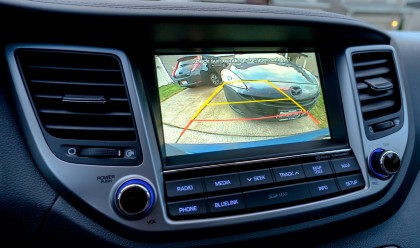
DBC is a neat little feature that helps getting the Tucson down steep hills, ideally where there's ice, snow or other slippery surfaces. Simply press the button located below the shifter and the car automatically controls the brake and throttle to get the car down the incline at 5 mph. I tested this feature going down a steep hill in the rain, where the technology isn't necessarily needed, but it was the only place I could test it.
I found DBC to be a lot easier to use than attempting to work the brakes to maintain a slower speed going down a steep incline. This feature can be a lifesaver for those who live atop a steep hill where it snows or freezes over a lot, and makes life easier for more experienced drivers.
LDW is a purely passive affair. It's only active when the LDW indicator in the gauge cluster is green, which is at speeds above 40 mph, like most other cars. The system alerts you if you're about to depart the lane with a visual display in the gauge cluster, plus a series of annoying beeps if you leave the lane.
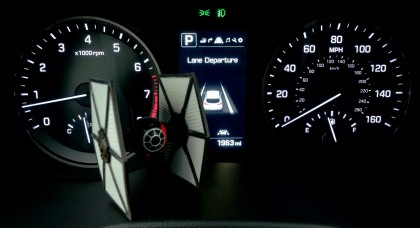
I find passive LDW systems more of an annoyance, but I don't have trouble staying within the lane markers or need a reminder otherwise. Fortunately, Hyundai makes it easy to disable the system with a button on the dashboard, to the left of the steering wheel.
AEB is a feature that should work in theory, but not something I can safely test outside of a controlled environment. Nevertheless, AEB can detect imminent collision and apply full braking capabilities, the equivalent of slamming on the brakes, at speeds of 5 to 50 mph. It can also detect pedestrians and brake immediately when traveling from 5 to 43 mph, in case someone decides to jaywalk when you're not paying attention.
Hyundai lets you set the sensitivity of the AEB system via the gauge cluster LCD, so you can adjust it to suit your level of driving attentiveness. While AEB, when it's working, can help deter accidents, it's not a substitute for being alert and attentive while driving, but should only serve as an aid for worse-case scenarios.
Missing from the suite of driver assists is adaptive cruise control (ACC), unfortunately. The car is designed to accommodate the feature, but Hyundai chose not to offer it yet – for an undisclosed reason. Hyundai plans on offering ACC on the recently unveiled Elantra, which shares a platform with the Tucson.
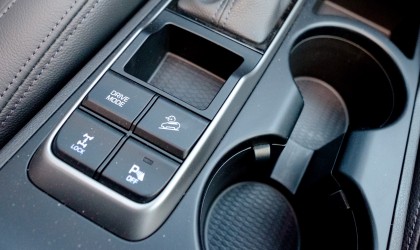
Nevertheless, my chats with Hyundai representatives reveal the Tucson can accommodate ACC if the company chooses to include it. There's a spot in the center console for the electronic parking brake that would replace the '80s truck-like foot-operated parking brake, if Hyundai were to offer its excellent full-speed range smart cruise control system.
Blue Link
Exclusive to the range-topping Limited trim is Hyundai's Blue Link telematics system that provides a smartphone app to remotely control vehicle features and roadside assistance. The Blue Link mobile app is available for Android and iOS devices, including a companion app for Android Wear and the Apple Watch.
I tested the Blue Link app on my Motorola Nexus 6 and Asus ZenWatch and found the app to be simple and functional. You can lock, unlock, remote start, trigger the horn and lights, send navigation locations directly to the car, and check vehicle status using the Blue Link app. The smartwatch companion app has most of the same functions as the smartphone app.
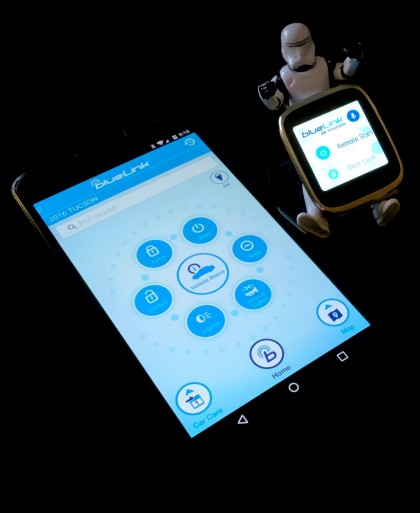
I find the novelty of remote starting my car from my smartwatch entertaining, but it's not something I can see myself using regularly. If you live in the snow belt, remote start is a huge nicety to have for cold mornings, but there's one caveat to Blue Link: subscription costs.
A one-year trial period comes with every new Blue Link-equipped Hyundai vehicle for the peace of mind services in the Connected Care Package, but the Remote Package that enables the smartphone apps has a reduced, three-month trial period. However, the subscription cost is $99 (Blue Link is not available in the UK or AUS) a year, which works out to $8.25 a month, for the Remote Package.
The price for Hyundai's remote features sounds reasonable – no more than a Google Music or Netflix subscription – but you also need the $99-a-year Connected Care Assurance Package to even consider the Remote Package. For a grand total of $200 a year, or about $17 a month, you can remotely control your car from a smartphone app.
I personally wouldn't pay for any of the Blue Link services. I'm carrying on just fine with an "old fashioned" remote start button on the key fob, since that doesn't require a subscription to use.
Current page: Audio, driver assists and BlueLink
Prev Page Design, interior and infotainment Next Page Performance and living with it